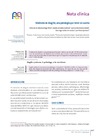Identificador persistente para citar o vincular este elemento:
https://accedacris.ulpgc.es/jspui/handle/10553/41642
| Campo DC | Valor | idioma |
|---|---|---|
| dc.contributor.author | Ortega Pérez, S. N. | en_US |
| dc.contributor.author | González Santana, D. | en_US |
| dc.contributor.author | Ramos Varela, J. C. | en_US |
| dc.contributor.author | Cañizo Fernández, D. | en_US |
| dc.contributor.author | Peña Quintana, Luis | en_US |
| dc.date.accessioned | 2018-07-24T11:40:20Z | - |
| dc.date.available | 2018-07-24T11:40:20Z | - |
| dc.date.issued | 2017 | en_US |
| dc.identifier.issn | 1139-7632 | en_US |
| dc.identifier.uri | https://accedacris.ulpgc.es/handle/10553/41642 | - |
| dc.description.abstract | El síndrome de Alagille es una patología poco frecuente. Afecta a uno de cada 100 000 recién nacidos vivos. Se caracteriza por una hipoplasia de vías biliares que se asocia a otras malformaciones. Se presenta el caso de un niño chino de cuatro años al que se le diagnosticó esta patología tras ser adoptado a los 11 meses de edad. | en_US |
| dc.description.abstract | Alagille syndrome is an uncommon pathology. It is found in 1/100,000 live births. It is characterized by biliary duct hypoplasia associated with other malformations. We report the case of a four-year-old Chinese child who was diagnosed with this pathology after being adopted at 11 months of age. | en_US |
| dc.language | spa | en_US |
| dc.relation.ispartof | Pediatria de Atencion Primaria | en_US |
| dc.source | Pediatria de Atencion Primaria [ISSN 1139-7632], v. 19 (75), p. 267-270 | en_US |
| dc.subject | 3207 Patología | en_US |
| dc.subject | 320503 Gastroenterología | en_US |
| dc.subject.other | Colestasis | en_US |
| dc.subject.other | Enfermedades de los conductos biliares | en_US |
| dc.subject.other | Síndrome de Alagille | en_US |
| dc.subject.other | Alagille syndrome | en_US |
| dc.subject.other | Bile duct diseases | en_US |
| dc.subject.other | Cholestasis | en_US |
| dc.title | Síndrome de Alagille; una patología que tener en cuenta | en_US |
| dc.title.alternative | Alagille syndrome. A pathology to be considered | en_US |
| dc.type | info:eu-repo/semantics/article | es |
| dc.type | Article | es |
| dc.description.lastpage | 270 | - |
| dc.identifier.issue | 75 | - |
| dc.description.firstpage | 267 | - |
| dc.relation.volume | 19 | - |
| dc.investigacion | Ciencias de la Salud | en_US |
| dc.type2 | Artículo | en_US |
| dc.identifier.ulpgc | Sí | es |
| dc.description.sjr | 0,122 | |
| dc.description.sjrq | Q4 | |
| item.fulltext | Con texto completo | - |
| item.grantfulltext | open | - |
| crisitem.author.dept | GIR IDeTIC: División de Procesado Digital de Señales | - |
| crisitem.author.dept | IU para el Desarrollo Tecnológico y la Innovación | - |
| crisitem.author.dept | Departamento de Señales y Comunicaciones | - |
| crisitem.author.dept | GIR IUIBS: Nutrición | - |
| crisitem.author.dept | IU de Investigaciones Biomédicas y Sanitarias | - |
| crisitem.author.dept | Departamento de Ciencias Clínicas | - |
| crisitem.author.orcid | 0000-0002-4621-2768 | - |
| crisitem.author.orcid | 0000-0001-6052-5894 | - |
| crisitem.author.parentorg | IU para el Desarrollo Tecnológico y la Innovación | - |
| crisitem.author.parentorg | IU de Investigaciones Biomédicas y Sanitarias | - |
| crisitem.author.fullName | Travieso González, Carlos Manuel | - |
| crisitem.author.fullName | Peña Quintana, Luis | - |
| Colección: | Artículos | |
Visitas
136
actualizado el 04-ene-2025
Descargas
54
actualizado el 04-ene-2025
Google ScholarTM
Verifica
Comparte
Exporta metadatos
Los elementos en ULPGC accedaCRIS están protegidos por derechos de autor con todos los derechos reservados, a menos que se indique lo contrario.
